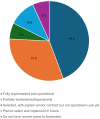Electronic Health Record Implementation Enhances Financial Performance in High Medicaid Nursing Homes
- PMID: 38803618
- PMCID: PMC11129737
- DOI: 10.2147/JMDH.S457420
Electronic Health Record Implementation Enhances Financial Performance in High Medicaid Nursing Homes
Abstract
Introduction: The nursing home (NH) industry operates within a two-tiered system, wherein high Medicaid NHs which disproportionately serve marginalized populations, exhibit poorer quality of care and financial performance. Utilizing the resource-based view of the firm, this study aimed to investigate the association between electronic health record (EHR) implementation and financial performance in high Medicaid NHs. A positive correlation could allow high Medicaid NHs to leverage technology to enhance efficiency and financial health, thereby establishing a business case for EHR investments.
Methods: Data from 2017 to 2018 were sourced from mail surveys sent to the Director of Nursing in high Medicaid NHs (defined as having 85% or more Medicaid census, excluding facilities with over 10% private pay or 8% Medicare), and secondary sources like LTCFocus.org and Centers for Medicare & Medicaid Services cost reports. From the initial sample of 1,050 NHs, a 37% response rate was achieved (391 surveys). Propensity score inverse probability weighting was used to account for potential non-response bias. The independent variable, EHR Implementation Score (EIS), was calculated as the sum of scores across five EHR functionalities-administrative, documentation, order entry, results viewing, and clinical tools-and reflected the extent of electronic implementation. The dependent variable, total margin, represented NH financial performance. A multivariable linear regression model was used, adjusting for organizational and market-level control variables that may independently affect NH financial performance.
Results: Approximately 76% of high Medicaid NHs had implemented EHR either fully or partially (n = 391). The multivariable regression model revealed that a one-unit increase in EIS was associated with a 0.12% increase in the total margin (p = 0.05, CI: -0.00-0.25).
Conclusion: The findings highlight a potential business case -long-term financial returns for the initial investments required for EHR implementation. Nonetheless, policy interventions including subsidies may still be necessary to stimulate EHR implementation, particularly in high Medicaid NHs.
Keywords: electronic health records; financial performance; health information technology; high-Medicaid nursing homes.
© 2024 Dayama et al.
Conflict of interest statement
The authors declare no competing interests in this work.
Figures
References
-
- National Center for Health Statistics. Nursing Home Care; 2018. Available from: https://www.cdc.gov/nchs/fastats/nursing-home-care.htm. Accessed December 31, 2023.
-
- Welch WP, Ruhter J, Bosworth A, Lew N, Sommers BD Changes of ownership of hospital and skilled nursing facilities: an analysis of newly-released CMS data; 2022. Available from: https://aspe.hhs.gov/reports/changes-ownership-hospital-skilled-nursing-.... Accessed April 11, 2024.
-
- Singletary E, Roiland R, Harker M, Taylor D Value-based payment and skilled nursing facilities: supporting SNFs during COVID19 and beyond; 2021.
-
- The Medicaid and CHIP Payment and Access Commission.Estimates of Medicaid nursing facility payments relative to costs; 2023. Available from: https://www.macpac.gov/publication/estimates-of-medicaid-nursing-facilit.... Accessed April 14, 2024.
LinkOut - more resources
Full Text Sources




